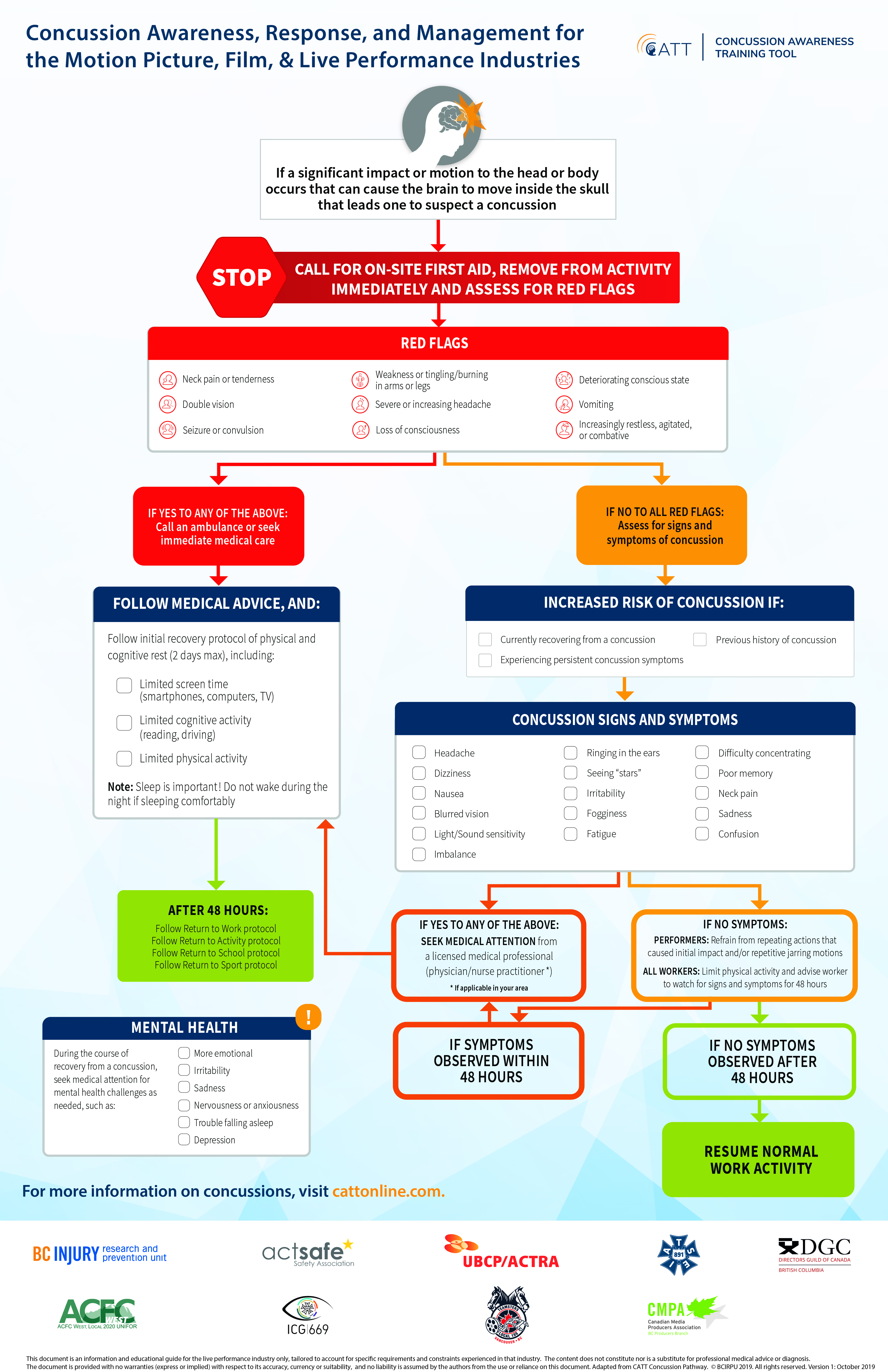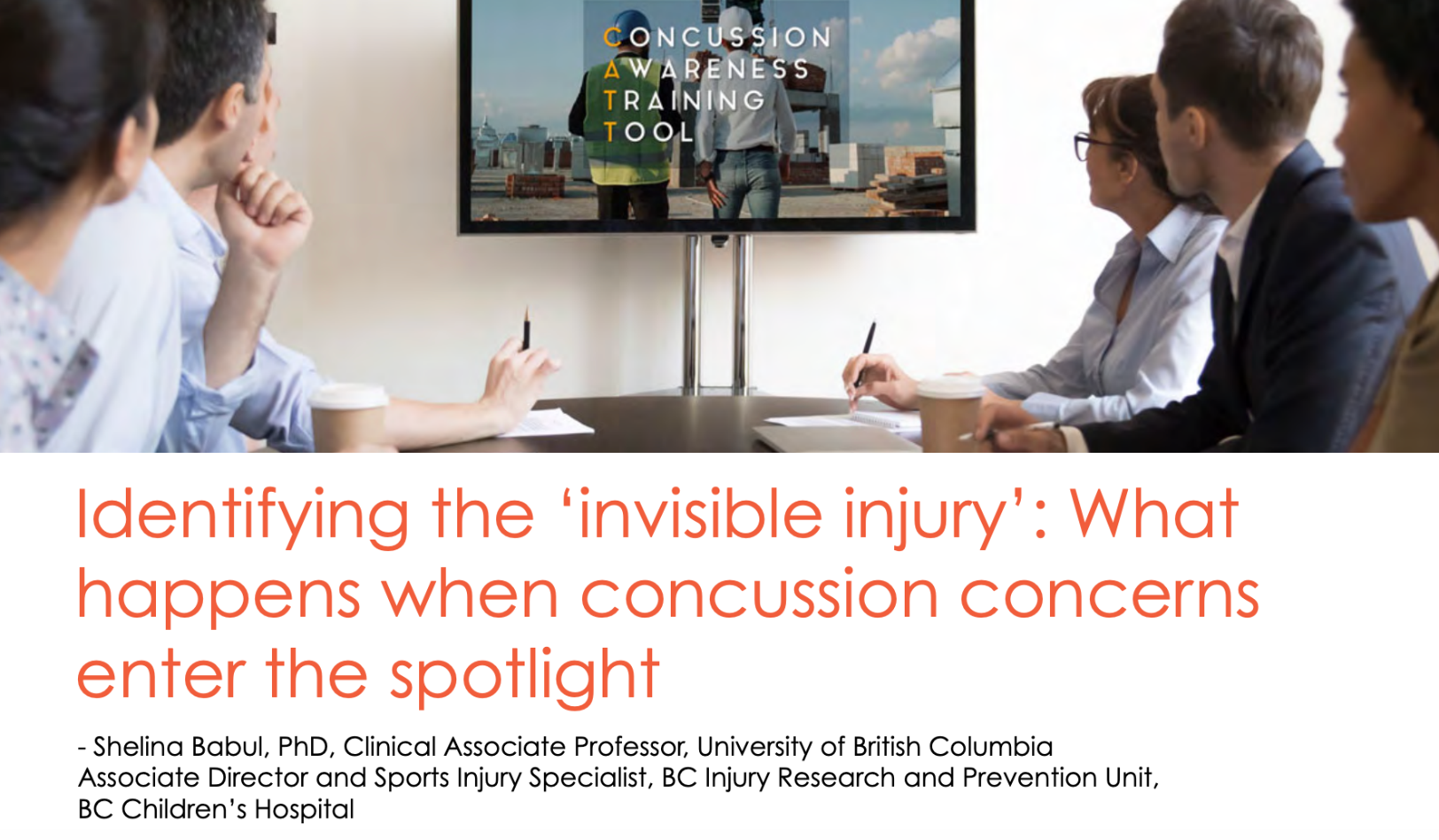Whether it’s on a movie set, backstage, off-camera, or during rehearsal, a concussion-causing event can occur. Due to the complex, high-pressure work environments of the motion picture, television, live event and performing arts industries, workers face situations every day that put them at risk for sustaining this traumatic brain injury.
– Shelina Babul, PhD, Clinical Associate Professor, University of British Columbia Associate Director and Sports Injury Specialist, BC Injury Research and Prevention Unit, BC Children’s Hospital
A concussion is the most common form of brain injury. Concussions occur when the head or body sustains a significant impact or jolt that causes the brain to move inside the skull. Concussion knowledge and education can help: minimize the risk of concussion, guide appropriate response to a potential concussion incident, properly manage symptoms, and support recovery.
What’s the problem?
It is estimated that 1 in 165 Canadian adults suffer a concussion each year. Concussion was the third most reported type of WorkSafeBC serious injury claim in 2016. Yet, experts suspect that concussions are under-reported and that these numbers are larger, including in the motion picture and performing arts industries. A recent cross-sectional survey among actors and theatre technicians in the United States determined that 67% had experienced at least one theatre-related head impact, 77% of participants reported 3 or more, and over 33% reported experiencing more than 5 theatre-related head impacts. Among those who sustained head impacts at work, 70% experienced concussion-related symptoms but continued to work, and nearly half of those did not report the incident.
How does it affect me?
Without appropriate education and support, the pressure to perform and tight production schedules can result in performers and employees returning to work prematurely, putting them at risk for re-injury and delayed recovery. It may even result in them not reporting their concussion at all, and workplace hazards can go unaddressed.
Most adults recover from a concussion within four weeks, but unfortunately approximately 30% experience persistent symptoms. After one concussion, the brain is more susceptible to sustaining another. With each subsequent concussion, there is a further risk of experiencing long-term physical, emotional, and psychological symptoms. Second-impact syndrome—although rare—is extremely dangerous and can result in death. This occurs when someone suffers a second concussion before the first concussion has time to fully heal. Quick recognition and action when a concussion incident occurs can go a long way in managing the recovery process and avoiding long-term disability.
In 2012, Actsafe commissioned a survey and review of BC film stunt performers and stunt related injuries, concluding that head injuries were frequent and widely under-reported. The main reason for not reporting an injury was a lack of recognition of the severity of the injury. Other factors included the sense that injury was a part of a job, the belief that reporting would harm future work prospects, and perceived difficulties in dealing with the regulatory
agency.
Additional industry-specific challenges include: fast-paced work environments; tight production schedules; working at multiple locations; jobs with high risk for injury such as stunt performers, dancers, and acrobats; repeated actions that can aggravate the initial injury; and long work hours with reduced sleep can also elevate risk of injury and high concussion rates.
What can I do to learn more about concussion?
The Concussion Awareness Training Tool (CATT, cattonline.com), a free online resource for medical professionals, coaches, parents, teachers, athletes, and working adults to provide the latest evidence-based information on concussion, was created in 2013. In collaboration with Lori Stewart, Health & Safety Performer Advocate at UBCP/ACTRA, Philippe Saucier at SportMedBC, and the Actsafe Safety Association, we developed an industry-specific resource: the Concussion Awareness, Response, and Management for the Motion Picture, Film & Live Performance Industries Pathway to improve concussion care among employees of this sector.
This flowchart outlines a pathway to guide the appropriate response and management of a suspected concussion. This resource outlines steps to follow immediately after a potential concussion-causing incident, identifies red flags (signs that immediate medical assistance is required), common concussion signs and symptoms, and suggestions for management. To learn more, the CATT e-learning course for Workers and Workplaces (CATT WW) is available free-of-charge and can help ensure that concussions are identified early and managed
correctly.
Remember! It is not a good idea to repeat the action that caused the potential concussion incident: it’s dangerous! Concussions can happen to anyone, anywhere, and at any time. Inappropriate response, ignoring, or mismanaging a concussion can make symptoms worse, lengthen recovery, and cause long-term consequences. Concussions aren’t visible, like a broken arm or bruise. It is everyone’s responsibility to know how to deal with this invisible injury.
Visit cattonline.com to learn more about concussions and access resources.

This article was written for our quarterly newsletter, Safety Scene. You can find a link to the full edition below.




Share Now: